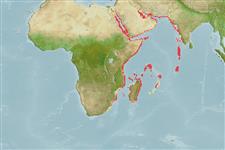>
Gobiiformes (Gobies) >
Gobiidae (Gobies) > Gobiinae
Etymology: Eviota: No etymology given, suggested by Christopher Scharpt: from Latin 'eu' for 'true' and 'iota' for anything very small, in combination 'truly very small' referring to it as being the smallest vertebrate at the time it has benn described by Jenkins (thus, making the suggestion by Scharpt plausible.
More on authors: Lachner & Karnella.
Environment: milieu / climate zone / depth range / distribution range
Ecologia
marinhas associadas(os) a recifes; intervalo de profundidade 1 - 15 m (Ref. 48637). Tropical
Indian Ocean: Red Sea, Gulf of Aqaba, Gulf of Oman, Seychelles, and Maldives. Records from the Pacific Ocean are most likely E. cf. teresae (except Fiji with E. teresae).
Tamanho / Peso / Idade
Maturity: Lm ? range ? - ? cm
Max length : 3.2 cm TL macho/indeterminado; (Ref. 11344)
Descrição breve
Chaves de identificação | Morfologia | Morfometria
Espinhos dorsais (total) : 6 - 7; Raios dorsais moles (total) : 8 - 9; Espinhos anais: 1; Raios anais moles: 8 - 9. This species is similar to Eviota albolineata in having similar counts or measurements. Color differences in live and preserved materials are distinct, however, with E. guttata having a dark spot on the ventral side of the head on the isthmus, about in line with the posterior portion of the maxilla and presence of a few scattered melanophores on the underside of the lower jaw near the tip, the intensity of the dark pigmentation varies, from a few melanophores to a very dark area (absent in E. albolineata) (Ref. 83982). Dorsal to anal fin-ray formula 9/8 (Ref. 116739).
Inhabits shallow reefs with mixed algae and coral growth to about 15 meters depth (Ref. 48637). Occurs in coastal and insular areas.
Life cycle and mating behavior
Maturidade | Reprodução | Desova | Ovos | Fecundidade | Larvas
Lachner, E.A. and S.J. Karnella, 1978. Fishes of the genus Eviota of the Red Sea with descriptions of three new species (Teleostei: Gobiidae). Smithson. Contrib. Zool. 286:23 p. (Ref. 11636)
Categoria na Lista Vermelha da IUCN (Ref. 130435: Version 2024-1)
Ameaça para o homem
Harmless
Utilização humana
Ferramentas
Relatórios especiais
Descarregue XML
Fontes da internet
Estimates based on models
Preferred temperature (Ref.
123201): 24.7 - 29.3, mean 28.3 °C (based on 3568 cells).
Phylogenetic diversity index (Ref.
82804): PD
50 = 0.5000 [Uniqueness, from 0.5 = low to 2.0 = high].
Bayesian length-weight: a=0.00794 (0.00402 - 0.01570), b=3.06 (2.90 - 3.22), in cm total length, based on LWR estimates for this species & Genus-body shape (Ref.
93245).
Nível Trófico (Ref.
69278): 3.1 ±0.3 se; based on size and trophs of closest relatives
Resiliência (Ref.
120179): Elevada, tempo mínimo de duplicação da população menor que 15 meses (Preliminary K or Fecundity.).
Fishing Vulnerability (Ref.
59153): Low vulnerability (10 of 100).
Nutrients (Ref.
124155): Calcium = 367 [158, 1,005] mg/100g; Iron = 1.46 [0.65, 3.21] mg/100g; Protein = 17.7 [15.6, 19.5] %; Omega3 = 0.0971 [, ] g/100g; Selenium = 30.1 [9.5, 85.9] μg/100g; VitaminA = 110 [24, 506] μg/100g; Zinc = 3.96 [2.23, 6.46] mg/100g (wet weight);
